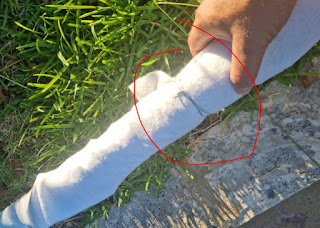Varroa has arrived in Australia and is wreaking havoc in the eastern states. As it slowly advances toward us, now is the time to take action: educate ourselves, learn how to monitor effectively, and become familiar with treatment options.
Below is an image of a corn cob. Although corn relies on wind for pollination, it serves as a powerful analogy for what could happen when our essential pollinators falter under the burden of increasing pest pressure.
The Time to Act is Now: Prepare for Varroa and Protect Your Bees
Every beekeeper needs to be informed and proactive as Varroa approaches. Recently, I attended a training hosted by WA DPIRD, and while it was a long and detailed day, the information shared was absolutely vital.
The session began with an overview of Varroa and quickly moved into treatment options, highlighting their implications and best practices. Even after completing the training, I recognize the need to carefully map out when and how to apply treatments, considering factors like our specific sites, floral schedules, expected mite loads, and seasonal dynamics. Choosing the right product and factoring in temperature ranges for effectiveness adds complexity to the process.
Western Australia’s extended beekeeping season and the need for neighboring beekeepers to manage their hives effectively make this challenge even greater. A neglected hive in your area can become a “mite bomb,” leading to re-infestations and undoing your hard work.
Understanding Treatment Rules in Australia
Not all treatment products can be used according to the label instructions. In Australia, legislation requires compliance with the Australian Honey Bee Code of Practice, which takes precedence over product label directions. Beekeepers are legally responsible for ensuring treatments are used according to Australian regulations, which may differ significantly from international guidelines. Misuse of treatments not only risks harm to your hives but could also lead to non-compliance with the law.
The Danger of Improper Treatment Use
Using treatments incorrectly or failing to rotate products properly can result in Varroa mites developing resistance, rendering once-effective treatments useless. This is why understanding the approved treatment methods and their appropriate usage is so important.
It’s important to remember: there is no silver bullet for Varroa. Experimenting with untested methods in your backyard could result in disastrous mite explosions that harm your colonies.
Key Takeaway: Monitoring, Compliance, and Planning are Critical
DPIRD is currently offering free inspections by their VDOs (Volunteer Diagnostic Officers). They can provide valuable guidance and, if they spot your queen, they’ll even mark her for you—how good is that?
Why Sign Up for Training?
- Learn how to monitor your hive effectively.
- Familiarize yourself with treatment options and how to use them in compliance with Australian law.
- Gain the knowledge you need before you face an infestation—waiting until it’s too late could create major pest issues.
- Receive a free set of materials to help you monitor your hives and maintain records.
Take Action Now!
The training is free, and the skills you gain could make all the difference for your bees and your community.






























